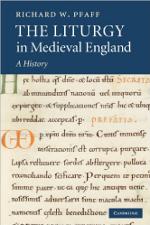 Jeg har nå lest ferdig denne boka, som forfatteren, Richard W. Pfaff, i forordet skriver kanskje heller burde ha blit kalt The Liturgical Books of Medieval England, eller enda bedre (men for langt) The Liturgy in Medieval England: An Essay on the History of Medieval England as seen through Liturgical Sources.
Jeg har nå lest ferdig denne boka, som forfatteren, Richard W. Pfaff, i forordet skriver kanskje heller burde ha blit kalt The Liturgical Books of Medieval England, eller enda bedre (men for langt) The Liturgy in Medieval England: An Essay on the History of Medieval England as seen through Liturgical Sources.
Boka handlet nok for mye om utallige manuskripter etter min smak, og enkelte av detaljene må jeg innrømme jeg leste ganske raskt. Boka (som er på 575 sider) er delvis historisk, delvis går den gjennom liturgiene til de ulike religiøse ordenene i England, og mot slutten også de ulike regionale liturgiene, som Sarum (Salisbury), York, Hereford, Lincoln og et par til. Sarum er den mest kjente liturgien/ messerordningen, som etter hvert kom til å dominere det meste av England.
Fra en annen kilde kan vi lese om rubrikkene i Susrum-messen (i tillegg skriver Pfaff også en del om forskjellige tekster og helgenkalendere i de ulike tradisjonene):
The following are the more noticeable variants of the Use of Sarum from the developed Roman Rite:
At Mass, as in the Dominican Use, the Sarum priest began by saying a verse of the psalm «Confitemini,» with a shortened Confiteor followed by the verse «Adjutorium nostrum in nomine Domini.» Nevertheless, at Salisbury every celebrant was bound to have recited the whole psalm «Judica me Deus» in the sacristy before coming to the foot of the altar. The prayer «Aufer a nobis» was said, but not that which now follows it, in lieu of which the priest simply made the sign of the cross and proceeded to read the Officium, or as we call it, the Introit.
From the Kyrie to the Offertory the deviations from our actual usage are slight, though on festival days this section of the sacred rite was often enormously lengthened by varied and prolix sequences. Like the Dominican and other contemporaneous Uses, that of Sarum supposes the previous preparation of the chalice (put by the Sarum Missal between the Epistle and Gospel) and thereby materially abbreviates the Offertory ceremonial.
According to an archaic usage, still familiar to ourselves from the Roman Good-Friday Rite, the prayer «In spiritu humilitatis» followed in place of preceding the washing of the priest’s hands and the psalm «Lavabo» was omitted. To the «Orate Fratres» (at Sarum, «Orate Fratres et Sorores») no audible response was made.
From the Preface onward through the Canon, the Sarum Mass was word for word and gesture by gesture that of our own Missals, except that a profound inclination of head and shoulders took the place of the modern genuflection and that during the first prayer after the Elevation the celebrant stood with arms stretched out in the form of a cross. As in France and generally in Northern and Western Europe the Benediction given at the breaking of the Sacred Host was not curtailed to the mere pronouncing of the words «Pax Domini sit semper vobiscum» but, more particularly when a bishop officiated, was very solemnly given with a formula varying according to the festival.
The prayers before the priest’s Communion were other than those with which we are familiar. The kiss of peace was given as with us but there was no «Domine non sum dignus.» The words pronounced by the celebrant at the moment of his own Communion are striking and seem peculiar to the Sarum Missal. They may therefore be fittingly quoted: «Hail for evermore, Thou most holy Flesh of Christ; sweet to me before and beyond all things beside. To me a sinner may the Body of our Lord Jesus Christ be the Way and the Life.» The Communion and Postcommunion followed as now. But no Blessing was given, and the beginning of the Gospel of St. John was recited by the priest on his way from the sanctuary to the sacristy.
